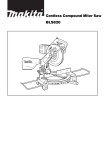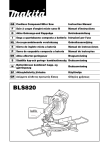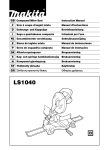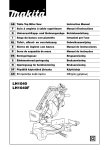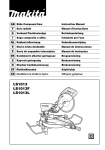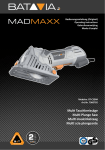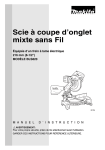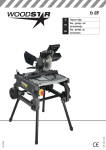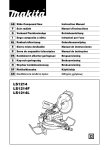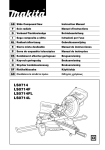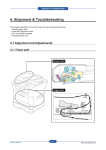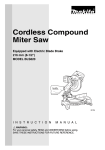Download Makita BLS820 Instruction manual
Transcript
GB Cordless Compound Miter Saw Instruction Manual F Scie à coupe d’onglet mixte sans fil Manuel d’instructions D Akku Gehrungs-und Kappsäge Betriebsanleitung I Sega a quartabuono composta a batteria Istruzioni per l’uso NL Accu-gecombineerde verstekzaag Gebruiksaanwijzing E Sierra de inglete mixta a batería Manual de instrucciones P Serra de esquadria composta a bateria Manual de instruções DK Akku afkorter-geringssav Brugsanvisning S Sladdlös kap-och gerings- kombinationssåg Bruksanvisning N Batteridreven kombinert kapp- og gjæringssag Bruksanvisning SF Akkuyhdistetty jiirlsaha Käyttöohje GR Ασύρµατο σύνθετος πριονωτς δίσκος Οδηγίες χρήσεως BLS820 66 45 66 45 8 8 1 67 2 2 5 3 4 1 3 4 6 7 5 7 6 8 11 3 9 12 5 3 10 7 2 13 8 15 16 14 17 12 13 5 3 13 9 10 9 11 3 10 8 10 11 12 19 18 20 21 13 14 24 15 21 22 15 23 25 26 16 3 27 26 28 32 31 29 25 17 30 18 34 35 33 19 36 37 38 20 25 40 39 41 34 45 44 26 42 43 21 22 46 47 42 23 4 24 43 49 43 50 51 48 25 26 52 27 28 53 54 42 55 29 30 25 31 56 32 5 58 29 57 30 33 34 57 15 33 59 28 38 61 60 35 36 37 63 62 37 38 65 64 39 6 Symbols The followings show the symbols used for tool. Be sure that you understand their meaning before use. Symboles Nous donnons ci-dessous les symboles utilisés pour l’outil. Assurez-vous que vous en avez bien compris la signification avant d’utiliser l’outil. Symbole Die folgenden Symbole werden für die Maschine verwendet. Machen Sie sich vor der Benutzung unbedingt mit ihrer Bedeutung vertraut. Simboli Per questo utensile vengono usati i simboli seguenti. Bisogna capire il loro significato prima di usare l’utensile. Symbolen Voor dit gereedschap worden de volgende symbolen gebruikt. Zorg ervoor dat u de betekenis van deze symbolen begrijpt alvorens het gereedschap te gebruiken. Símbolos A continuación se muestran los símbolos utilizados con esta herramienta. Asegúrese de que entiende su significado antes de usarla. Símbolos O seguinte mostra os símbolos utilizados para a ferramenta. Certifique-se de que compreende o seu significado antes da utilização. Symboler Nedenstående symboler er anvendt i forbindelse med denne maskine. Vær sikker på, at De har forstået symbolernes betydning, før maskinen anvendes. Symboler Det följande visar de symboler som används för den här maskinen. Se noga till att du förstår deras innebörd innan maskinen används. Symbolene Følgende viser de symblene som brukes for maskinen. Det er viktig å forstå betydningen av disse før maskinen tas i bruk. Symbolit Alla on esitetty koneessa käytetyt symbolit. Opettele näiden merkitys, ennen kuin käytät konetta. Σύµβολα Τα ακλουθα δείχνουν τα σύµβολα που χρησιµοποιούνται για το µηχάνηµα. Βεβαιωθείτε τι καταλαβαίνετε τη σηµασία τους πριν απ τη χρήση. ❏ To avoid injury from flying debris, keep holding the saw head down, after making cuts, until the blade has come to a complete stop. ❏ Pour éviter toute blessure résultant du vol de débris, tenez l’outil avec sa tête dirigée vers le bas lorsque la coupe est terminée, jusqu’à ce que la lame soit complètement arrêtée. ❏ Um Verletzungen durch herausgeschleuderte Teile zu vermeiden, halten Sie den Maschinenkopf nach Ausführung von Schnitten abgesenkt, bis die Trennscheibe völlig zum Stillstand gekommen ist. ❏ Per evitare le ferite causate dalle schegge volanti, mantenere abbassata la testa della fresa dopo i tagli finché la lama non si è fermata completamente. ❏ Na het maken van sneden, moet u de zaagkop omlaag blijven houden totdat het zaagblad volledig tot stilstand is gekomen, om mogelijke verwonding door vliegende brokstukken te voorkomen. ❏ Para evitar heridas a causa de restos volanderos, después de efectuar los cortes mantenga bajada la cabeza del tronzador hasta que el disco se pare completamente. ❏ Para evitar injúrias causadas por fragmentos que se soltem, mantenha a cabeça da serra para baixo, depois de fazer cortes, até que a lâmina esteja completamente parada. ❏ For at undgå tilskadekomst forårsaget af flyvende afskær skal savhovedet holdes nede efter afskæringen, indtil skiven er helt standset. ❏ Håll såghuvudet nedåt, efter avslutad kapning, tills klingan har stannat helt, för att undvika skador från flygande skräp. ❏ For å forhindre skader fra spon og flis som spres omkring, må saghodet holdes nede etter at kuttene er gjort helt til bladet har stoppet. ❏ Estä lentävien roskien aiheuttama loukkaantuminen pitämällä sahan kärkiosa sahauksen jälkeen alhaalla, kunnes terä on kokonaan pysähtynyt. ❏ Για να αποφύγετε τραυµατισµ απ ιπτάµενα γρέζια, κρατάτε τον κπτη προς τα κάτω, αφού κάνετε την κοπή, µέχρι η λεπίδα να σταµατήσει εντελώς. 7 ❏ For your safety, remove the chips, small pieces, etc. from the table top before operation. ❏ A des fins de sécurité, débarrassez la table de tous les copeaux et autres petits débris avant le travail. ❏ Zur Sicherheit sollte die Tischplatte vor dem Betrieb von Spänen, Kleinteilen usw. gesäubert werden. ❏ Per la propria sicurezza, rimuovere le bave, scorie, ecc., da sopra il tavolo dopo il lavoro. ❏ Voor uw veiligheid, verwijder spaanders, brokstukjes, enz. van het tafelblad alvorens het gereedschap te bedienen. ❏ Para su propia seguridad, quite las virutas, pequeÞos trozos, etc., de encima de la mesa antes de realizar la operaciün de corte. ❏ Para sua segurança, retire as aparas, peças pequenas, etc. de cima da bancada antes de começar a operação. ❏ For Deres sikkerheds skyld skal alle metalspåner, små dele og så videre fjernes fra bordets overflade før anvendelse. ❏ Ta bort spån, småpartiklar osv. från sågbordets ovansida före användningen, för din egen säkerhets skull. ❏ Av sikkerhetsmessige årsaker må spon, metallstykker, etc. fjernes fra bordet før arbeidet starter. ❏ Poista oman turvallisuutesi vuoksi lastut, pienet kappaleet yms pöydän pinnalta ennen työskentelyä. ❏ Για την ασφάλεια σας , αποµακρύνετε τα υπολείµατα, µικρά κοµµάτια κλπ. απ το τραπέζι προτού χρησιµοποιείσετε το µηχάνηµα. 8 ❏ Only for EU countries Do not dispose of electric equipment together with household waste material! In observance of European Directive 2002/96/EC on waste electrical and electronic equipment and its implementation in accordance with national law, electric equipment that have reached the end of their life must be collected separately and returned to an environmentally compatible recycling facility. ❏ Pour les pays européens uniquement Ne pas jeter les équipements électriques dans les ordures ménagères ! Conformément à la directive européenne 2002/96/EG relative aux déchets d’équipements électriques ou électroniques (DEEE), et à sa transposition dans la législation nationale, les équipements électriques doivent être collectés à part et être soumis à un recyclage respectueux de l’environnement. ❏ Nur für EU-Länder Werfen Sie Elektrogeräte nicht in den Hausmüll! Gemäß Europäischer Richtlinie 2002/96/EG über Elektro- und Elektronik-Altgeräte und Umsetzung in nationales Recht müssen verbrauchte Elektrogeräte getrennt gesammelt und einer umweltgerechten Wiederverwertung zugeführt werden. ❏ Solo per Paesi UE Non gettare le apparecchiature elettriche tra i rifiuti domestici. Secondo la Direttiva Europea 2002/96/CE sui rifiuti di apparecchiature elettriche ed elettroniche e la sua attuazione in conformità alle norme nazionali, le apparecchiature elettriche esauste devono essere raccolte separatamente, al fine di essere riciclate in modo eco-compatibile. ❏ Alleen voor EU-landen Geef elektrische apparaten niet met het huisvuil mee! Volgens de Europese richtlijn 2002/96/EG inzake oude elektrische en elektronische apparaten en de toepassing daarvan binnen de nationale wetgeving, dient gebruikt elektrische apparaten gescheiden te worden ingezameld en te worden afgevoerd naar een recycle bedrijf dat voldoet aan de geldende milieu-eisen. ❏ Sólo para países de la Unión Europea ¡No deseche los aparatos eléctricos junto con los residuos domésticos! De conformidad con la Directiva Europea 2002/96/CE sobre residuos de aparatos eléctricos y electrónicos y su aplicación de acuerdo con la legislación nacional, los aparatos eléctricos cuya vida útil haya llegado a su fin se deberán recoger por separado y trasladar a una planta de reciclaje que cumpla con las exigencias ecológicas. ❏ Apenas para países da UE Não deite ferramentas eléctricas no lixo doméstico! De acordo com a directiva europeia 2002/96/CE sobre ferramentas eléctricas e electrónicas usadas e a sua aplicação para as leis nacionais, as ferramentas eléctricas usadas deven ser recolhidas em separado e encaminhadas a uma instalação de reciclagem dos materiais ecológicos. ❏ Kun for EU-lande Elværktøj må ikke bortskaffes som almindeligt affald! I henhold til det europæiske direktiv 2002/96/EF om bortskaffelse af elektriske og elektroniske produkter og gældende national lovgivning skal brugt elværktøj indsamles separat og returneres til miljøgodkendt genindvinding. ❏ Gäller endast EU-länder Elektrisk utrustning får inte kastas i hushållssoporna! Enligt direktivet 2002/96/EG som avser äldre elektrisk och elektronisk utrustning och dess tillämpning enligt nationell lagstiftning ska uttjänt elektrisk utrustning sorteras separat och lämnas till miljövänlig återvinning. ❏ Kun for EU-land Kast aldri elektriske produkter i husholdningsavfallet! I henhold til EU-direktiv 2002/96/EF om kasserte elektriske og elektroniske produkter og direktivets iverksetting i nasjonal rett, må elektriske produkter som ikke lenger skal brukes, samles separat og returneres til et miljøvennlig gjenvinningsanlegg. ❏ Koskee vain EU-maita Älä hävitä sähkölaitteita tavallisen kotitalousjätteen mukana! Vanhoja sähkö- ja elektroniikkalaitteita koskevan EU-direktiivin 2002/96/ETY ja sen maakohtaisten sovellusten mukaisesti sähkölaitteet on toimitettava ongelmajätteen keräyspisteeseen ja ohjattava ympäristöystävälliseen kierrätykseen. ❏ Μνο για τις χώρες της ΕΕ Μη πετάτε τα είδη ηλεκτρικού εξοπλισµού µαζί µε τα οικιακά απορρίµµατα. Σε τήρηση της Eυρωπαϊκής Oδηγίας 2002/96/ΕΚ, περί απορριµµάτων ειδών ηλεκτρικού και ηλεκτρονικού εξοπλισµού και την εφαρµογή της σύµφωνα µε την εθνική νοµοθεσία, τα είδη ηλεκτρικού εξοπλισµού που έχουν φθάσει στο τέλος της ζωής τους πρέπει να συλλέγονται ξεχωριστά και να επιστρέφονται σε µιά περιβαλλοντικά συµβατή εγκατάσταση ανακύκλωσης. 9 ENGLISH Explanation of general view 1 2 3 4 5 6 7 8 9 10 11 12 13 14 15 16 17 18 19 20 21 22 23 24 Battery cartridge Button Socket wrench Wrench holder Blade case Stopper pin Bolts Hex bolt Center cover Safety cover (Safety guard) Arrow Shaft lock Hex bolt (left-handed) Outer flange Saw blade Inner flange Spindle Dust nozzle Dust bag Fastener Kerf board Left bevel cut Straight cut Adjusting bolt 25 26 27 28 29 30 31 32 33 34 35 36 37 38 39 40 41 42 43 44 45 46 47 48 Guide fence Turn base Periphery of blade Top surface of turn base Miter scale Pointer Grip Lock lever Lever Loosen Tighten Bevel scale Pointer Arm Vise rod Vise arm Vise knob Holder Holder assembly Vise knob Base Vise shaft Projection Rods 12 49 50 51 52 53 54 55 56 57 58 59 60 61 62 63 64 65 66 67 Lock-off button Handle Switch trigger Lock lever Apply pressure in parallel with blade Set plate Screw Hex bolt Triangular rule Screw 45° bevel angle adjusting bolt 0° bevel angle adjusting bolt Sub arm Screw Limit mark Screwdriver Brush holder cap Auxiliary plate Nut SPECIFICATIONS Model BLS820 Blade diameter....................................................................................................................... 210 mm – 216 mm Hole (arbor) diameter For European countries.......................................................................................................................... 30 mm For all other countries.......................................................................................................... 25.4 mm or 25 mm For North and Central American countries........................................................................................ 15.88 mm Max. cutting capacities (H x W) with blade 216 mm in diameter Bevel angle Miter angle 0° 45° (left and right) 0° 45° (left) 61 mm x 122 mm 45 mm x 122 mm 61 mm x 85 mm 45 mm x 85 mm -1) ................................................................................................................................. 2,300 No load speed (min Dimensions (L x W x H) .........................................................................................528 mm x 430 mm x 486 mm Net weight (with battery cartridge) ........................................................................................................... 10.1 kg Rated Voltage ...................................................................................................................................... D.C. 24 V • Due to our continuing program of research and development, the specifications herein are subject to change without notice. • Note: Specifications may differ from country to country. IMPORTANT SAFETY INSTRUCTIONS FOR BATTERY CARTRIDGE ENC005-1 1. Safety hints For your own safety, please refer to the enclosed safety instructions. 2. 3. 4. 10 Before using battery cartridge, read all instructions and cautionary markings on (1) battery charger, (2) battery, and (3) product using battery. Do not disassemble battery cartridge. If operating time has become excessively shorter, stop operating immediately. It may result in a risk of overheating, possible burns and even an explosion. If electrolyte gets into your eyes, rinse them out with clear water and seek medical attention right away. It may result in loss of your eyesight. 5. 6. 7. 8. Do not short the battery cartridge: (1) Do not touch the terminals with any conductive material. (2) Avoid storing battery cartridge in a container with other metal objects such as nails, coins, etc. (3) Do not expose battery cartridge to water or rain. A battery short can cause a large current flow, overheating, possible burns and even a breakdown. Do not store the tool and battery cartridge in locations where the temperature may reach or exceed 50°C (122°F). Do not incinerate the battery cartridge even if it is severely damaged or is completely worn out. The battery cartridge can explode in a fire. Be careful not to drop or strike battery. SAVE THESE INSTRUCTIONS. Tips for maintaining maximum battery life 1. 2. 3. 4. Charge the battery cartridge before completely discharged. Always stop tool operation and charge the battery cartridge when you notice less tool power. Never recharge a fully charged battery cartridge. Overcharging shortens the battery service life. Charge the battery cartridge with room temperature at 10°C – 40°C (50°F – 104°F). Let a hot battery cartridge cool down before charging it. Charge the Nickel Metal Hydride battery cartridge when you do not use it for more than six months. ADDITIONAL SAFETY RULES FOR TOOL ENB041-3 1. Be aware that this tool is always in an operating condition, because it does not have to be plugged into an electrical outlet. 2. Wear eye protection. 3. Keep hands out of path of saw blade. Avoid contact with any coasting blade. It can still cause severe injury. 4. Do not operate saw without guards in place. Check blade guard for proper closing before each use. Do not operate saw if blade guard does not move freely and close instantly. Never clamp or tie the blade guard into the open position. 5. Do not perform any operation freehand. The workpiece must be secured firmly against the turn base and guide fence with the vise during all operations. Never use your hand to secure the workpiece. 6. Never reach around saw blade. 7. Turn off tool and wait for saw blade to stop before moving workpiece or changing settings. 8. Remove battery from tool before chaging blade or servicing. 9. Don’t use the tool in the presence of flammable liquids or gases. 10. Check the blade carefully for cracks or damage before operation. Replace cracked or damaged blade immediately. 11. Use only flanges specified for this tool. 12. Be careful not to damage the arbor, flanges (especially the installing surface) or bolt. Damage to these parts could result in blade breakage. 13. Make sure that the turn base is properly secured so it will not move during operation. 14. For your safety, remove the chips, small pieces, etc. from the table top before operation. 15. Avoid cutting nails. Inspect for and remove all nails from the workpiece before operation. 16. Make sure the shaft lock is released before the switch is turned on. 17. Be sure that the blade does not contact the turn base in the lowest position. 18. Hold the handle firmly. Be aware that the saw moves up or down slightly during start-up and stopping. 19. Make sure the blade is not contacting the workpiece before the switch is turned on. 20. Before using the tool on an actual workpiece, let it run for a while. Watch for vibration or wobbling that could indicate poor installation or a poorly balanced blade. 21. Wait until the blade attains full speed before cutting. 22. Stop operation immediately if you notice anything abnormal. 23. Do not attempt to lock the trigger in the on position. 24. Be alert at all times, especially during repetitive, monotonous operations. Don’t be lulled into a false sense of security. Blades are extremely unforgiving. 25. Always use accessories recommended in this manual. Use of improper accessories such as abrasive wheels may cause an injury. 26. Do not use the saw to cut other than wood or similar materials. 27. Connect miter saws to a dust collecting device when sawing. 28. Select saw blades in relation to the material to be cut. 29. Take care when slotting. 30. Replace the kerf board when worn. Do not use saw blades manufactured from high speed steel. Some dust created from operation contains chemicals known to cause cancer, birth defects or other reproductive harm. Some examples of these chemicals are: • lead from lead-based-painted material and, • arsenic and chromium from chemically-treated lumber. Your risk from these exposures varies, depending on how often you do this type of work. To reduce your exposure to these chemicals: work in a well ventilated area and work with approved safety equipment, such as those dust masks that are specially designed to filter out microscopic particles. To reduce the emitted noise, always be sure that the blade is sharp and clean. The operator is adequately trained in the use, adjustment and operation of the machine. Use correctly sharpened saw blades. Observe the maximum speed marked on the saw blade. Refrain from removing any cut-offs or other parts of the workpiece from the cutting area whilst the machine is running and the saw head is not in the rest position. SAVE THESE INSTRUCTIONS. 11 OPERATING INSTRUCTIONS Installing auxiliary plate (Fig. 1 & 2) Always installing the auxiliary plate using the notch in the tool’s base and secure it by tightening the hex bolt before operation. Installing or removing battery cartridge (Fig. 3) • Always switch off the tool before insertion or removal of the battery cartridge. • To remove the battery cartridge, withdraw it from the tool while sliding the button on the side of the cartridge. • To insert the battery cartridge, align the tongue on the battery cartridge with the groove in the housing and slip it into place. Always insert it all the way until it locks in place with a little click. If not, it may accidentally fall out of the tool, causing injury to you or someone around you. • Do not use force when inserting the battery cartridge. If the cartridge does not slide in easily, it is not being inserted correctly. Socket wrench (Fig. 4) The socket wrench is stored as shown in Fig. 4. When using the socket wrench, pull it out of the wrench holder. After using the socket wrench, return it to the wrench holder. Bench mounting saw (Fig. 5 & 6) When the tool is shipped, the handle is locked in the lowered position by the stopper pin. Release the stopper pin by lowering the handle slightly and pulling the stopper pin. This tool should be bolted with four bolts to a level and stable surface using the bolt holes provided in the tool’s base. This will help prevent tipping and possible injury. Installing or removing saw blade CAUTION: • Always be sure that the tool is switched off and the battery cartridge is removed before installing or removing the blade. • Use only the Makita socket wrench provided to install or remove the blade. Failure to do so may result in overtightening or insufficient tightening of the hex bolt. This could cause serious injury to operator or others in the general vicinity of the tool. Lock the handle in the raised position by pushing in the stopper pin. (Fig. 5) To remove the blade, use the socket wrench to loosen the hex bolt holding the center cover by turning it counterclockwise. Raise the safety cover and center cover. (Fig. 7) Press the shaft lock to lock the spindle and use the socket wrench to loosen the hex bolt (left-handed) clockwise. Then remove the hex bolt, outer flange and blade. (Fig. 8) To install the blade, mount it carefully onto the spindle, making sure that the direction of the arrow on the surface of the blade matches the direction of the arrow on the blade case. Install the outer flange and hex bolt, and then use the socket wrench to tighten the hex bolt (lefthanded) securely counterclockwise while pressing the shaft lock. (Fig. 9 & 10) 12 CAUTION: For all countries other than European countries The inner flange has a 25 mm diameter on one side and a 25.4 mm diameter on the other. The side with 25.4 mm diameter is marked by “25.4”. Use the correct side for the hole diameter of the blade you intend to use. Mounting the blade on the wrong side can result in dangerous vibration. Return the safety cover and center cover to its original position. Then tighten the hex bolt clockwise to secure the center cover. (Fig. 11) Release the handle from the raised position by pulling the stopper pin. Lower the handle to make sure that the safety cover moves properly. Safety cover (Fig. 12) When lowering the handle, the safety cover rises automatically. The cover returns to its original position when the cut is completed and the handle is raised. NEVER DEFEAT OR REMOVE THE SAFETY COVER. In the interest of your personal safety, always maintain the safety cover in good condition. Any irregular operation of the safety cover should be corrected immediately. NEVER USE THE TOOL WITH A FAULTY SAFETY COVER. If the see-through safety cover becomes dirty, or sawdust adheres to it in such a way that the blade and/or workpiece is no longer easily visible, remove the battery cartridge and clean the cover carefully with a damp cloth. Do not use solvents or any petroleum-based cleaners on the plastic cover. Dust bag (Fig. 13) The use of the dust bag makes cutting operations clean and dust collection easy. To attach the dust bag, fit the bag’s entry port over the dust nozzle. When the dust bag is about half full, remove the dust bag from the tool and pull the fastener out. Empty the dust bag of its contents, tapping it lightly so as to remove particles adhering to the insides which might hamper further collection. Positioning kerf board (Fig. 14 & 15) This tool is provided with the kerf boards in the turn base. The kerf boards are factory adjusted so that the saw blade does not contact the kerf boards. Before use, adjust the kerf boards as follows: First, remove the battery cartridge. Loosen the all screws (2 each on left and right) securing the kerf boards. Retighten them to the extent that the kerf boards can be easily moved by hand. Lower the handle fully and push in the stopper pin to lock the handle in the lowered position. Adjust the kerf boards so that the kerf boards just contact the sides of blade teeth slightly. Tighten the screws (do not tighten firmly). After adjusting the kerf boards, release the stopper pin and raise the handle. Then tighten the all screws securely. CAUTION: After changing the bevel angle, always readjust the kerf boards as described above. Maintaining maximum cutting capacity (Fig. 16 & 17) This tool is factory adjusted to provide the max. cutting capacity for a 216 mm saw blade. When using a saw blade other than 216 mm saw blade, adjust the lower limit position of the blade as follows: First, remove the battery cartridge. Lower the handle completely. Use the socket wrench to turn the adjusting bolt until the periphery of the blade extends slightly below the top surface of the turn base at the point where the front face of the guide fence meets the top surface of the turn base. With the battery cartridge removed, rotate the blade by hand while holding the handle all the way down to be sure that the blade does not contact any part of the lower base. Re-adjust slightly, if necessary. Securing workpiece WARNING: It is extremely important to always secure the workpiece properly and tightly with the vise. Failure to do so can cause the tool to be damaged and/or the workpiece to be destroyed. PERSONAL INJURY MAY ALSO RESULT. Also, after a cutting operation, DO NOT raise the blade until the blade has come to a complete stop. 1. Vertical vise (Fig. 21) The vertical vise can be installed in two positions on either the left or right side of the guide fence, or the holder assembly (optional accessory). Insert the vise rod into the hole in the guide fence or the holder assembly and tighten the screw to secure the vise rod. (Note: When using the holder assembly, install it on the holder as shown in Fig. 21.) Position the vise arm according to the thickness and shape of the workpiece and secure the vise arm by tightening the screw. Make sure that no part of the tool contacts the vise when lowering the handle fully. If some part contacts the vise, re-position the vise. Press the workpiece flat against the guide fence and the turn base. Position the workpiece at the desired cutting position and secure it firmly by tightening the vise knob. The maximum thickness of workpieces which can be secured by the vertical vise is 61 mm. 2. Horizontal vise (optional accessory) (Fig. 22 & 23) The horizontal vise can be installed on either the left or right side of the base. By turning the vise knob counterclocwise, the screw is released and the vise shaft can be moved rapidly in and out. To grip workpieces, turn the vise knob gently clockwise until the projection reaches its topmost position, then fasten securely. If the vise knob is forced in or pulled out while being turned clockwise, the projection may stop at an angle. In this case, turn the vise knob back counterclockwise until the screw is released, before turning again gently clockwise. The maximum width of workpieces which can be secured by the horizontal vise is 122 mm. 3. Holders and holder assembly (optional accessory) The holders and the holder assembly can be installed on either side as a convenient means of supporting workpieces horizontally. Install them as shown in Fig. 24. Then tighten the screws firmly to secure the holders and the holder assembly. (Fig. 24) When cutting long workpieces, use the holder-rod assembly (optional accessory). It consists of two holder assemblies and two rods 12. (Fig. 25) CAUTION: After installing a new blade, always be sure that the blade does not contact any part of the lower base when the handle is lowered completely. Always do this with the battery cartridege removed. Positioning for adjusting the miter angle (Fig. 18) The turn base turns up to 52° to the left and right. Loosen the grip by turning counterclockwise. Turn the turn base while pressing down the lock lever. When you have moved the grip to the position where the pointer points to the desired angle on the miter scale, securely tighten the grip clockwise. CAUTION: • When turning the turn base, be sure to raise the handle fully. • After changing the miter angle, always secure the turn base by tightening the grip firmly. Positioning for adjusting the bevel angle (Fig. 19 & 20) The saw blade tilts up to 45° to the left. To adjust the bevel angle, loosen the lever at the rear of the tool. Push the handle to the left to tilt the saw blade until the pointer points to the desired angle on the bevel scale. Tighten the lever to secure the arm. CAUTION: • When tilting the saw blade, be sure to raise the handle fully. • After changing the bevel angle, always secure the arm by tightening the lever. CAUTION: Always support long workpieces level with the top surface of the turn base for accurate cuts and to prevent dangerous loss of control of the tool. 13 CAUTION: • During a bevel cut, it may create a condition whereby the piece cut off will come to rest against the side of the blade. If the blade is raised while the blade is still rotating, this piece may be caught by the blade, causing fragments to be scattered around which is dangerous. The blade should be raised ONLY after the blade has come to a complete stop. • When pressing down the handle, apply pressure in parallel with the blade. If a force is applied perpendicularly to the turn base or if the pressure direction is changed during a cut, the precision of the cut will be impaired. Switch action (Fig. 26) CAUTION: • Before inserting the battery cartridge into the tool, always check to see that the switch trigger actuates properly and returns to the “OFF” position when released. • When not using the tool, remove the lock-off button and store it in a secure place. This prevents unauthorized operation. To prevent the switch trigger from being accidentally pulled, a lock-off button is provided. To start the tool, press in the lock-off button and pull the trigger. Release the switch trigger to stop. Lock lever (Fig. 27) 4. For European countries only When cutting, push the lock lever to the left to release the handle from the raised position. When the cut is completed, release the lock lever after returning the blade to its fully elevated position. The handle will be automatically locked in the raised position. Operation CAUTION: Do not apply excessive pressure on the handle when cutting. Too much force may result in overload of the motor and/or decreased cutting efficiency. 1. Press cutting (Fig. 28) • Workpieces up to 61 mm high x 122 mm wide can be cut in the following way. • Secure the workpiece with the vise. Switch on the tool and wait until the blade attains full speed before lowering gently into the cut. When the cut is completed, switch off the tool and WAIT UNTIL THE BLADE HAS COME TO A COMPLETE STOP before returning the blade to its fully elevated position. 2. Miter cutting Refer to the previously covered “Positioning for adjusting the miter angle”. 3. Bevel cut (Fig. 29) • At a left 45° bevel angle, workpieces up to 45 mm high x 122 mm wide can be cut. • Loosen the lever and tilt the saw blade to set the bevel angle. Refer to the previously covered “Positioning for adjusting the bevel angle”. Secure the workpiece with the vise. Switch on the tool and wait until the blade attains full speed. Then gently lower the handle to the fully lowered position while applying pressure in parallel with the blade. When the cut is completed, switch off the tool and WAIT UNTIL THE BLADE HAS COME TO A COMPLETE STOP before returning the blade to its fully elevated position. 14 Compound cutting Compound cutting is the process in which a bevel angle is made at the same time in which a miter angle is being cut on a workpiece. Compound cutting can be performed at angle shown in the table below. Miter angle Bevel angle Left and right 45° Left 0° – 45° Left and right 52° Left 0° – 40° At the miter angle of left 45° and bevel angle of left 45°, workpieces 45 mm high x 85 mm wide can be cut. When performing compound cutting, refer to “Press cutting”, “Miter cutting” and “Bevel cut” explanations. 5. Cutting repetitive lengths (Fig. 30) When cutting several pieces of stock to the same length, ranging from 220 mm to 365 mm, use of the set plate (optional accessory) will facilitate more efficient operation. Install the set plate on the holder as shown in Fig. 30. Align the cutting line on your workpiece with either the left or right side of the groove in the kerf board, and while holding the workpiece from moving, move the set plate flush against the end of the workpiece. Then secure the set plate with the screw. When the set plate is not used, loosen the screw and turn the set plate out of the way. NOTE: Use of the holder-rod assembly (optional accessory) allows cutting repetitive lengths, ranging from 220 mm to 2,230 mm. Carrying tool (Fig. 5 & 31) Make sure that the battery cartridge is removed. Secure the blade at 0° bevel angle and the turn base at 52° miter angle to the right. Lower the handle fully and lock it in the lowered position by pushing in the stopper pin. Carry the tool by the carrying grip as shown in Fig. 31. MAINTENANCE Replacement of carbon brushes (Fig. 38 & 39) CAUTION: Always be sure that the tool is switched off and the battery cartridge is removed before carrying out any work on the tool. Remove and check the carbon brushes regularly. Replace when they wear down to the limit mark. Keep the carbon brushes clean and free to slip in the holders. Both carbon brushes should be replaced at the same time. Use only identical carbon brushes. Adjusting the cutting angle This tool is carefully adjusted and aligned at the factory, but rough handling may have affected the alignment. If your tool is not aligned properly, perform the following: 1. 2. Miter angle Loosen the grip which secures the turn base. Turn the turn base so that the pointer points to 0° on the miter scale. Then turn the turn base slightly clockwise and counterclockwise to seat the turn base cozily in the 0° miter notch. (Leave as it is if the pointer does not point to 0°.) Loosen the four hex bolts securing the guide fence using the socket wrench. (Fig. 32) Lower the handle fully and lock it in the lowered position by pushing in the lock pin. Square the side of the blade with the face of the guide fence using a triangular rule, try square, etc. Then securely tighten the hex bolts on the guide fence in the order from right side. (Fig. 33) Make sure that the pointer points to 0° on the miter scale. If the pointer does not point to 0°, loosen the screw which secures the pointer and adjust the pointer so that it will point to 0°. (Fig. 34) Bevel angle i) 0° bevel angle Lower the handle fully and lock it in the lowered position by pushing in the lock pin. Loosen the lever at the rear of the tool. Turn the 0° bevel angle adjusting bolt (lower bolt) on the right side of the arm two or three revolutions counterclockwise to tilt the blade to the right. (Fig. 35) Carefully sqaure the side of the blade with the top surface of the turn base using the triangular rule, try square, etc. by turning the 0° bevel angle adjusting bolt clockwise. Then tighten the lever securely. (Fig. 36) Make sure that the pointer on the sub arm points to 0° on the bevel scale on the arm. If it does not point to 0°, loosen the screw which secures the pointer and adjust the pointer so that it will point to 0°. (Fig. 37) ii) 45° bevel angle Adjust the 45° bevel angle only after performing 0° bevel angle adjustment. To adjust left 45° bevel angle, loosen the lever and tilt the blade 45° to the left. Make sure that the pointer on the sub arm points to 45° on the bevel scale on the arm. If the pointer does not point to 45°, turn the 45° bevel angle adjusting bolt (upper bolt) on the right side of the arm until the pointer points to 45°. (Fig. 35) Use a screwdriver to remove the brush holder caps. Take out the worn carbon brushes, insert the new ones and secure the brush holder caps. To maintain product safety and reliability, repairs, maintenance or adjustment should be carried out by a Makita Authorized Service Center. ACCESSORIES CAUTION: • These accessories or attachments are recommended for use with your Makita tool specified in this manual. The use of any other accessories or attachments might present a risk of injury to persons. Only use accessory or attachment for its stated purpose. If you need any assistance for more details regarding these accessories, ask your local Makita service center. • • • • • • • • • • • • • Dust bag Holder Socket wrench 10 Triangular rule Auxiliary plate Lock-off button (Switch button) Vertical vise Carbide-tipped saw blade Safety goggle Vise assembly (horizontal vise) Set plate Holder assembly Various type of Makita genuine batteries and chargers 15 NEDERLANDS Verklaring van algemene gegevens 1 2 3 4 5 6 7 8 9 10 11 12 13 14 15 16 17 18 19 20 21 22 23 Accu Knop Dopsleutel Sleutelhouder Zaagbladkast Aanslagpen Bouten Zeskantbout Middenkap Veiligheidskap (Beschermkap) Pijltje Asvergrendeling Zeskantbout (linkse schroefdraad) Buitenflens Zaagblad Binnenflens As Verbindingsstuk Stofzak Sluitstrip Zaagsnedeplaat Linkse versteksnede Rechte snede 24 25 26 27 28 29 30 31 32 33 34 35 36 37 38 39 40 41 42 43 44 45 46 Stelbout Geleider Draaibaar voetstuk Omtrek van zaagblad Bovenvlak van draaibaar voetstuk Verstekschaal Wijzer Handgreep Borgpen Hendel Losmaken Vastmaken Schuine-hoek schaal Wijzer Arm Spanschroefstang Spanschroefarm Spanschroefknop Houder Houdermontage Spanschroefknop Voetstuk Spanschroefas 47 48 49 50 51 52 53 54 55 56 57 58 59 60 61 62 63 64 65 66 67 Uitsteeksel Stangen 12 Ontgrendelknop Handvat Trekschakelaar Vergrendelknop Oefen druk uit evenwijdig met het zaagblad Stelplaat Schroef Zeskantbout Driehoeksliniaal Schroef Stelbout voor 45° schuine hoek Stelbout voor 0° schuine hoek Hulparm Schroef Limietmerkstreep Schroevendraaier Borstelhouderdop Hulpplaat Moer TECHNISCHE GEGEVENS Model BLS820 Diameter van zaagblad ..................................................................................................................... 210 mm — 216 mm Diameter van gat (asgat) Voor alle Europese landen ..................................................................................................................................30 mm Voor alle niet-Europese landen .........................................................................................................25,4 mm of 25 mm Voor landen in Noord- en Centraal-Amerika ................................................................................................. 15,88 mm Max. zaagkapaciteiten (H x B) met een zaagblad van 216 mm in diameter Schuine hoek Verstekhoek 0° 45° (links en rechts) 0° 45° (links) 61 mm x 122 mm 45 mm x 122 mm 61 mm x 85 mm 45 mm x 85 mm –1 Toerental onbelast (min ) .......................................................................................................................................2 300 Afmetingen (L x B x H) ........................................................................................................ 528 mm x 430 mm x 486 mm Netto gewicht (met accu) ......................................................................................................................................10,1 kg Nominale spanning ............................................................................................................................................. DC 24 V • In verband met ononderbroken research en ontwikkeling behouden wij ons het recht voor bovenstaande technische gegevens te wijzigen zonder voorafgaande kennisgeving. • Opmerking: De technische gegevens kunnen van land tot land verschillen. BELANGRIJKE VEILIGHEIDSVOORSCHRIFTEN VOOR ACCU Veiligheidswenken Voor uw veiligheid dient u de bijgevoegde Veiligheidsvoorschriften nauwkeurig op te volgen. 2. 3. 1. 4. Lees alle voorschriften en waarschuwingen op (1) de acculader, (2) de accu, en (3) het product waarvoor de accu wordt gebruikt, aandachtig door alvorens de acculader in gebruik te nemen. Neem de accu niet uit elkaar. Als de gebruikstijd van een opgeladen accu aanzienlijk korter is geworden, moet u het gebruik ervan onmiddellijk stopzetten. Voortgezet gebruik kan oververhitting, brandwonden en zelfs een ontploffing veroorzaken. Als er elektrolyt in uw ogen is terechtgekomen, spoel dan uw ogen met schoon water en roep onmiddellijk de hulp van een dokter in. Elektrolyt in de ogen kan blindheid veroorzaken. 35 5. 6. 7. 8. Voorkom kortsluiting van de accu: (1) Raak de accuklemmen nooit aan met een geleidend materiaal. (2) Bewaar de accu niet in een bak waarin andere metalen voorwerpen zoals spijkers, munten e.d. worden bewaard. (3) Stel de accu niet bloot aan water of regen. Kortsluiting van de accu kan oorzaak zijn van een grote stroomafgifte, oververhitting, brandwonden, en zelfs defecten. Bewaar het gereedschap en de accu niet op plaatsen waar de temperatuur kan oplopen tot 50°C of hoger. Werp de accu nooit in het vuur, ook niet wanneer hij zwaar beschadigd of volledig versleten is. De accu kan namelijk ontploffen in het vuur. Wees voorzichtig dat u de accu niet laat vallen en hem niet blootstelt aan schokken of stoten. BEWAAR DEZE VOORSCHRIFTEN. Tips voor een maximale levensduur van de accu 1. 2. 3. 4. Laad de accu op voordat hij volledig ontladen is. Stop het gebruik van het gereedschap en laad de accu op telkens wanneer u vaststelt dat het vermogen van het gereedschap is afgenomen. Laad een volledig opgeladen accu nooit opnieuw op. Als u de accu te veel oplaadt, zal hij minder lang meegaan. Laad de accu op bij een kamertemperatuur tussen 10°C en 40°C. Laat een warme accu afkoelen alvorens hem op te laden. Laad de nikkel-metaalhydride accu op telkens wanneer u hem langer dan zes maanden niet hebt gebruikt. AANVULLENDE VEILIGHEIDSVOORSCHRIFTEN VOOR HET GEREEDSCHAP 1. 2. 3. 4. 5. 6. 7. 8. 9. 36 Denk eraan dat dit gereedschap altijd gebruiksklaar is, aangezien het niet hoeft te worden aangesloten op een stopcontact. Draag oogbescherming. Houd uw handen uit de buurt van het zaagblad. Raak het freewheelende zaagblad niet aan, aangezien dit nog ernstige verwondingen kan veroorzaken. Gebruik de zaag niet zonder dat de beschermkappen zijn aangebracht. Zaag nooit met het werkstuk in uw hand. Zet het werkstuk met behulp van de spanschroef altijd stevig vast tegen het draaibare voetstuk en de geleider. Gebruik nooit uw hand om het werkstuk tijdens het zagen vast te houden. Probeer nooit om tijdens het zagen iets vast te pakken in de omgeving van het zaagblad. Schakel het gereedschap uit en wacht totdat het zaagblad volledig tot stilstand is gekomen alvorens het werkstuk te verwijderen of de instelling van het gereedschap te veranderen. Verwijder de accu uit het gereedschap alvorens het zaagblad te vervangen of met onderhoudswerkzaamheden te beginnen. Gebruik het gereedschap niet in de nabijheid van ontvlambare vloeistoffen of gassen. 10. Controleer het zaagblad zorgvuldig op barsten of beschadiging alvorens te gaan zagen. Vervang een gebarsten of beschadigd zaagblad onmiddellijk. 11. Gebruik alleen flenzen die voor dit gereedschap gemaakt zijn. 12. Let op dat u de as, de flenzen (vooral hun montagevlak) of de bout niet beschadigt. Beschadiging van deze onderdelen kan zaagbladbreuk veroorzaken. 13. Controleer of het draaibare voetstuk goed vastzit, zodat het tijdens het zagen niet kan bewegen. 14. Verwijder voor uw eigen veiligheid zaagafval, kleine stukjes hout e.d. van de werktafel alvorens te gaan zagen. 15. Zaag niet op spijkers. Inspecteer het werkstuk en trek alle eventuele spijkers eruit alvorens te gaan zagen. 16. Zet de asvergrendeling in de vrije stand alvorens de trekschakelaar in te drukken. 17. Zorg ervoor dat het zaagblad in zijn laagste positie niet in aanraking komt met het draaibare voetstuk. 18. Houd het handvat stevig vast. Denk eraan dat de zaag bij het starten en stoppen een beetje op en neer gaat. 19. Controleer vóór het inschakelen of het zaagblad het werkstuk niet raakt. 20. Laat het gereedschap een tijdje draaien alvorens het op uw werkstuk te gebruiken. Controleer op trillingen of schommelingen die kunnen wijzen op onjuiste installatie of een slecht gebalanceerd zaagblad. 21. Wacht totdat het zaagblad op volle toeren draait, alvorens het werkstuk te zagen. 22. Stop onmiddellijk met zagen indien u iets abnormaals opmerkt. 23. Probeer niet om de trekschakelaar in de AAN positie te vergrendelen. 24. Laat nooit uw aandacht verslappen, vooral niet wanneer het werk saai is en uit herhalingen bestaat. Laat u niet misleiden door een vals gevoel van veiligheid. Zaagbladen kunnen altijd gevaar opleveren. 25. Gebruik uitsluitend de accessoires die in deze gebruiksaanwijzing worden aanbevolen. Het gebruik van ongeschikte accessoires, zoals slijpschijven, kan verwonding veroorzaken. 26. Gebruik de zaag niet voor het zagen van andere materialen dan hout of gelijksoortige materialen. 27. Sluit verstekzagen tijdens het zagen aan op een stofvanginrichting. 28. Kies de zaagbladen in overeenstemming met het te zagen materiaal. 29. Wees voorzichtig wanneer u gleuven zaagt. 30. Vervang de zaagsnedeplaat indien deze versleten is. Zaagbladen van hooggelegeerd snelstaal (HSS) mogen niet worden gebruikt. Stof dat tijdens de werkzaamheden vrijkomt, kan chemische bestanddelen bevatten die kanker, geboortedefecten of andere voortplantingsschade kan (kunnen) verwekken. Enkele voorbeelden van deze chemische stoffen zijn: • lood van loodhoudende verfstoffen en • arsenicum en chroom van chemisch behandeld hout. Uw risico van deze blootstellingen varieert en hangt af van het feit hoe vaak u dit soort bewerkingen uitvoert. Om blootstelling aan deze chemische bestanddelen te verminderen, moeten de werkzaamheden uitgevoerd worden in een goed geventileerde werkomgeving en gebruikmakend van goedgekeurde veiligheidsmiddelen, zoals stofmaskers die ontworpen zijn om microscopisch kleine deeltjes te kunnen filteren. Zorg omwille van een lager geluidsniveau dat het zaagbladaltijd scherp en schoon is. De operator moet voldoende goed zijn opgeleid in het gebruik, de afstelling en het onderhoud van het gereedschap. Gebruik een zaagblad dat op de juiste wijze geslepen is. Houd u aan de maximale snelheid aangegeven op het zaagblad. Verwijder nooit afgezaagde delen of andere delen van het werkstuk uit het zaaggebied terwijl de machine draait en het zaagblad nog niet in de ruststand staat. BEWAAR DEZE VOORSCHRIFTEN. BEDIENINGSVOORSCHRIFTEN Installeren van de extra plaat (Fig. 1 en 2) Zorg ervoor dat bij het installeren van de extra plaat de inkeping in de voet van het gereedschap gebruikt wordt en dat de extra plaat wordt vastgezet door de zeskantbout aan te draaien alvorens het gereedschap te gebruiken. Installeren of verwijderen van de accu (Fig. 3) • Schakel het gereedschap altijd uit alvorens de accu te installeren of te verwijderen. • Om de accu te verwijderen, neemt u deze uit het gereedschap terwijl u de knop op de zijkant van de accu verschuift. • Om de accu te installeren, past u de tong op de accu in de groef in het accuhuis en dan schuift u de accu erin. Schuif de accu zo ver mogelijk erin, totdat deze met een klikgeluid vergrendelt. Indien u dit niet doet, kan de accu per ongeluk uit het gereedschap vallen en uzelf of anderen verwonden. • Probeer niet de accu met geweld in het accuhuis te duwen. Indien de accu niet gemakkelijk erin gaat, betekent dit dat u hem niet op de juiste wijze erin steekt. Dopsleutel (Fig. 4) De dopsleutel is aangebracht zoals afgebeeld in Fig. 4. Wanneer u de dopsleutel wilt gebruiken, moet u deze uit de sleutelhouder trekken. Breng de dopsleutel na gebruik weer in de sleutelhouder aan. De zaag op een werktafel monteren (Fig. 5 en 6) Bij de verscheping uit de fabriek, is het handvat van het gereedschap in de omlaagpositie vastgezet door middel van de aanslagpen. Ontgrendel de aanslagpen door het handvat een beetje omlaag te drukken en de aanslagpen naar buiten te trekken. Dit gereedschap moet op een horizontaal en stabiel oppervlak worden gemonteerd door middel van vier bouten die u door de boutgaten in het voetstuk van het gereedschap steekt. Hierdoor wordt voorkomen dat het gereedschap omkantelt en mogelijk verwondingen veroorzaakt. Installeren of verwijderen van het zaagblad LET OP: • Controleer altijd of het gereedschap is uitgeschakeld en de accu ervan is verwijderd alvorens het zaagblad te installeren of te verwijderen. • Gebruik voor het installeren of verwijderen van het zaagblad uitsluitend de bijgeleverde Makita dopsleutel. Doet u dit niet, dan kan de zeskantbout te vast of te los worden aangedraaid, hetgeen ernstige verwonding van de gebruiker van het gereedschap of van anderen in de nabije omgeving tot gevolg kan hebben. Druk de aanslagpen naar binnen om het handvat in de omhoogpositie vast te zetten. (Fig. 5) Om het zaagblad te verwijderen, gebruik de dopsleutel om de zeskantbout, die de middenkap op zijn plaats houdt, naar links los te draaien. Breng de veiligheidskap en de middenkap omhoog. (Fig. 7) Druk de asvergrendeling in om de as te vergrendelen en draai met de dopsleutel de zeskantbout (linkse schroefdraad) naar rechts los. Verwijder vervolgens de zeskantbout, de buitenflens en het zaagblad. (Fig. 8) Om het zaagblad te installeren, monteert u het zaagblad voorzichtig op de as, ervoor zorgend dat de pijltjes op het zaagblad en op de zaagbladkast in dezelfde richting wijzen. Monteer de buitenflens en de zeskantbout, en draai dan met de dopsleutel de zeskantbout (linkse schroefdraad) stevig naar links vast terwijl u daarbij de asvergrendeling ingedrukt houdt. (Fig. 9 en 10) LET OP: Voor alle niet-Europese landen De binnenflens heeft een diameter van 25 mm aan de ene zijde, en een diameter van 25,4 mm aan de andere zijde. De zijde met een diameter van 25,4 mm is gemarkeerd met “25.4”. Gebruik de zijde die overeenkomt met de asgatdiameter van het zaagblad dat u gaat gebruiken. Indien het zaagblad aan de verkeerde zijde wordt gemonteerd, kan gevaarlijke trilling worden veroorzaakt. Monteer de veiligheidskap en de middenkap weer in hun oorspronkelijke posities. Zet daarna de middenkap vast door de zeskantbout naar rechts vast te draaien. (Fig. 11) Trek de aanslagpen naar buiten om het handvat uit zijn omhoogpositie te ontgrendelen. Breng het handvat omlaag om te controleren of de veiligheidskap behoorlijk beweegt. Veiligheidskap (Fig. 12) Wanneer het handvat omlaag wordt gebracht, gaat de veiligheidskap automatisch omhoog. De veiligheidskap keert naar haar oorspronkelijke positie terug wanneer het zagen beëindigd is en het handvat omhoog wordt gebracht. ZET DE VEILIGHEIDSKAP NOOIT VAST EN VERWIJDER DEZE NOOIT. Voor uw persoonlijke veiligheid dient de veiligheidskap altijd in goede staat te worden gehouden. Elke onregelmatige werking van de veiligheidskap dient onmiddellijk te worden hersteld. GEBRUIK HET GEREEDSCHAP NOOIT MET EEN DEFECTE VEILIGHEIDSKAP. Wanneer de doorzichtige veiligheidskap vuil is of met zaagsel is bedekt zodat u het zaagblad en/of het werkstuk niet meer behorlijk kunt zien, verwijder dan de accu van het gereedschap en reinig de veiligheidskap zorgvuldig met een bevochtigde doek. Gebruik geen oplosmiddelen of benzinehoudende schoonmaakmiddelen op de plastic kap. 37 Stofzak (Fig. 13) Instellen van de verstekhoek (Fig. 18) Door de stofzak te gebruiken wordt het zaagsel opgevangen en kunt u schoon werken. Voor het bevestigen van de stofzak monteert u de inlaat van de stofzak over het verbindingsstuk op het gereedschap. Wanneer de stofzak ongeveer halfvol is, verwijdert u deze van het gereedschap en trekt u de sluitstrip eraf. Maak de stofzak leeg en tik er lichtjes op voor het verwijderen van achtergebleven stofdeeltjes waardoor de stofopvanging zou kunnen worden belemmerd. Het draaibaar voetstuk draait maximaal 52° naar links en naar rechts. Draai de handgreep naar links los. Verdraai het draaibaar voetstuk terwijl u de borgpen ingedrukt houdt. Beweeg de handgreep naar de positie waarbij de wijzer de gewenste hoek op de verstekschaal aanwijst en draai dan de handgreep weer stevig naar rechts vast. Afstellen van de zaagsnedeplaten (Fig. 14 en 15) Dit gereedschap is voorzien van zaagsnedeplaten in het draaibaar voetstuk. De zaagsnedeplaten zijn in de fabriek zodanig afgesteld dat het zaagblad niet met de zaagsnedeplaten in aanraking komt. Stel de zaagsnedeplaten als volgt af alvorens het gereedschap in gebruik te nemen: Verwijder eerst de accu van het gereedschap. Draai alle schroeven (2 aan de linkerzijde en 2 aan de rechterzijde) waarmee de zaagsnedeplaten zijn vastgemaakt los. Trek de schroeven weer aan zodanig dat de zaagsnedeplaten gemakkelijk met de hand kunnen worden bewogen. Breng het handvat volledig omlaag en druk de aanslagpen naar binnen om het handvat in de omlaagpositie te vergrendelen. Stel de positie van de zaagsnedeplaten zodanig af dat deze lichtjes in aanraking komen met de zijkanten van de zaagbladtanden. Trek de schroeven aan (niet te hard aantrekken). Nadat de zaagsnedeplaten zijn afgesteld, ontgrendelt u de aanslagpen en brengt u het handvat omhoog. Trek vervolgens alle schroeven stevig aan. LET OP: Telkens nadat u de schuine hoek hebt gewijzigd, dient u de zaagsnedeplaten opnieuw af te stellen op de bovenstaande wijze. Handhaven van de maximale zaagcapaciteit (Fig. 16 en 17) Dit gereedschap is in de fabriek ingesteld voor het leveren van maximale zaagcapaciteit met een 216 mm zaagblad. Wanneer u een ander dan een 216 mm zaagblad gebruikt, dient u de laagste positie van het zaagblad als volgt af te stellen: Verwijder eerst de accu van het gereedschap. Breng het handvat helemaal omlaag. Gebruik de dopsleutel en verdraai de stelbout totdat de omtrek van het zaagblad een beetje onder het bovenvlak van het draaibaar voetstuk komt te zitten op het punt waar het voorvlak van de geleider in aanraking komt met het bovenvlak van het draaibaar voetstuk. Zorg dat de accu uit het gereedschap is verwijderd en draai met de hand het zaagblad rond terwijl u het handvat volledig omlaag gedrukt houdt, en controleer of het zaagblad met geen enkel deel van het onderste voetstuk in aanraking komt. Stel opnieuw een beetje af, indien nodig. LET OP: Na het installeren van een nieuw zaagblad, dient u altijd te controleren of het zaagblad met geen enkel deel van het onderste voetstuk in aanraking komt wanneer het handvat volledig naar omlaag is gebracht. Verwijder voor deze controle altijd de accu uit het gereedschap. 38 LET OP: • Voor het verdraaien van het draaibaar voetstuk dient u het handvat in de hoogste positie te plaatsen. • Na het wijzigen van de verstekhoek, dient u het draaibaar voetstuk altijd vast te zetten door de handgreep stevig vast te draaien. Instellen van de schuine hoek (Fig. 19 en 20) Het zaagblad kan 45° schuin omhoog naar links worden gezet. Om de schuine hoek in te stellen, maakt u de hendel aan de achterzijde van het gereedschap los. Duw het handvat naar links om het zaagblad te kantelen totdat de wijzer naar de gewenste hoek op de schuine-hoek schaal wijst. Draai daarna de hendel weer vast om de arm te vergrendelen. LET OP: • Voor het schuin zetten van het zaagblad, dient u het handvat in de hoogste positie te plaatsen. • Na het wijzigen van de schuine hoek, dient u de arm altijd vast te zetten door de hendel vast te draaien. Vastzetten van het werkstuk WAARSCHUWING: Het is uiterst belangrijk dat u het werkstuk altijd juist en stevig vastzet met behulp van de spanschroef. Indien u dit nalaat, kan het gereedschap beschadiging oplopen en/of het werkstuk worden vernield. OOK KAN PERSOONLIJK LETSEL HET GEVOLG ZIJN. Nadat het zagen is beëindigd, dient u het zaagblad NIET omhoog te brengen alvorens het volledig tot stilstand is gekomen. 1. Verticale spanschroef (Fig. 21) De verticale spanschroef kan in twee posities aan de linkerzijde of de rechterzijde van de geleider of houdermontage (los verkrijgbaar accessoire) worden geïnstalleerd. Steek de stang van de spanschroef in het gat in de geleider of in de houdermontage en trek de schroef aan om de stang vast te zetten. (Opmerking: Wanneer u de houdermontage gebruikt, dient u deze op de houder te monteren zoals afgebeeld in Fig. 21.) Zet de arm van de spanschroef in de positie die geschikt is voor de dikte en vorm van het werkstuk en zet de arm vast door de schroef vast te draaien. Zorg ervoor dat geen enkel deel van het gereedschap in aanraking komt met de spanschroef wanneer het handvat volledig omlaag wordt gebracht. Indien een of ander deel met de spanschroef in aanraking komt, moet u de positie van de spanschroef opnieuw afstellen. Druk het werkstuk vlak tegen de geleider en het draaibaar voetstuk. Plaats het werkstuk in de gewenste zaagpositie en zet het stevig vast door de spanschroefknop vast te draaien. De maximale dikte van werkstukken die met de verticale spanschroef kunnen worden vastgezet is 61 mm. 2. 3. Horizontale spanschroef (los verkrijgbaar accessoire) (Fig. 22 en 23) De horizontale spanschroef kan aan de linker- of rechterzijde van het voetstuk worden geïnstalleerd. Door de spanschroefknop naar links te draaien wordt de spanschroef in de vrije stand gezet en kunt u de spanschroefas snel naar binnen en naar buiten bewegen. Om het werkstuk te grijpen, draait u de spanschroefknop langzaam naar rechts totdat het uitsteeksel in zijn hoogste positie komt te staan, en dan draait u de spanschroefknop stevig vast. Indien de spanschroefknop naar binnen of naar buiten wordt getrokken terwijl u deze naar rechts draait, kan het uitsteeksel in een schuine positie stoppen. In dat geval draait u de spanschroefknop terug naar links totdat de spanschroef los komt, en dan draait u deze weer langzaam naar rechts. De maximale breedte van werkstukken die met de horizontale spanschroef kunnen worden vastgezet is 122 mm. Houders en houdermontage (los verkrijgbaar accessoire) De houders en de houdermontage kunnen aan beide zijden van het gereedschap worden aangebracht als een handig middel voor het horizontaal ondersteunen van de werkstukken. Monteer deze zoals afgebeeld in Fig. 24. Trek de schroeven stevig aan om de houders en de houdermontage vast te zetten. (Fig. 24) Gebruik de houder/stang montage (los verkrijgbaar accessoire) voor het zagen van lange werkstukken. Deze bestaat uit twee houdermontages en twee stangen 12. (Fig. 25) LET OP: Om nauwkeurige zaagsneden te verkrijgen en gevaarlijk controleverlies van het gereedschap te voorkomen, dient u lange werkstukken altijd zo te ondersteunen dat deze op gelijke hoogte staan met het bovenvlak van het draaibaar voetstuk. Bediening LET OP: Oefen tijdens het zagen geen overmatige druk op het handvat uit. Wanneer u te hard drukt, kan de motor overbelast raken en/of de zaagcapaciteit verminderen. 1. Drukkend zagen (Fig. 28) • Werkstukken die maximaal 61 mm dik en 122 mm breed zijn kunt u als volgt zagen. • Zet het werkstuk vast met de spanschroef. Schakel het gereedschap in, wacht totdat het zaagblad op volle toeren draait, en laat dan de zaag voorzichtig op het werkstuk neerzakken. Nadat het zagen is beëindigd, schakelt u het gereedschap uit. WACHT TOTDAT HET ZAAGBLAD VOLLEDIG TOT STILSTAND IS GEKOMEN alvorens het zaagblad in zijn hoogste positie terug te zetten. 2. Verstekzagen Zie de paragraaf “Instellen van de verstekhoek” hierboven. 3. Schuine sneden zagen (Fig. 29) • Bij een linkse schuine hoek van 45°, kunt u werkstukken zagen die maximaal 45 mm dik en 122 mm breed zijn. • Draai de hendel los en houd het zaagblad schuin om de schuine hoek in te stellen. Zie de paragraaf “Instellen van de schuine hoek” hierboven. Zet het werkstuk vast met de spanschroef. Schakel het gereedschap in en wacht totdat het zaagblad op volle toeren draait. Breng dan het handvat langzaam tot in de laagste positie door druk uit te oefenen evenwijdig met het zaagblad. Nadat het zagen is beëindigd, schakelt u het gereedschap uit. WACHT TOTDAT HET ZAAGBLAD VOLLEDIG TOT STILSTAND IS GEKOMEN alvorens het zaagblad in zijn hoogste positie terug te zetten. Werking van de schakelaar (Fig. 26) LET OP: • Alvorens de accu in het gereedschap aan te brengen, dient u altijd te controleren of de trekschakelaar goed werkt en bij loslaten naar de “OFF” positie terugkeert. • Verwijder de ontgrendelknop en bewaar deze op een veilige plaats wanneer u het gereedschap niet gebruikt. Hierdoor voorkomt u ongeoorloofd gebruik van het gereedschap. Een ontgrendelknop is voorzien om te voorkomen dat de trekschakelaar per toeval wordt ingedrukt. Om het gereedschap te starten, drukt u eerst de ontgrendelknop en vervolgens de trekschakelaar in. Om het gereedschap te stoppen, de trekschakelaar loslaten. Vergrendelknop (Fig. 27) Alleen voor Europese landen Om te zagen, duwt u de vergrendelknop naar links om het handvat uit de omhoogpositie vrij te zetten. Nadat het zagen voltooid is, brengt u het zaagblad terug naar zijn hoogste positie en dan zet u de vergrendelknop in de vrije stand. Het handvat wordt dan automatisch in de omhoogpositie vastgezet. 4. LET OP: • Tijdens het zagen van schuine sneden kan het gebeuren dat het afgezaagd stuk tegen de zijkant van het zaagblad komt te liggen. Indien het zaagblad omhoog wordt gebracht terwijl het nog draait, kan dit stuk door het zaagblad worden gegrepen zodat brokstukken in het rond worden geslingerd, hetgeen natuurlijk gevaarlijk is. Breng daarom het zaagblad omhoog ALLEEN nadat dit volledig tot stilstand is gekomen. • Wanneer u het handvat omlaag drukt, dient u druk uit te oefenen evenwijdig met het zaagblad. Indien u verticale druk op het draaibaar voetstuk uitoefent of de drukrichting tijdens het zagen verandert, zal de zaagsnede minder nauwkeurig zijn. Gecombineerd zagen Gecombineerd zagen betekent dat het werkstuk tegelijk met een schuine hoek en een verstekhoek wordt gezaagd. Gecombineerd zagen is mogelijk voor hoeken aangegeven in de onderstaande tabel. Verstekhoek Schuine hoek 45° links en rechts 0° – 45° links 52° links en rechts 0° – 40° links 39 5. Bij een verstekhoek van 45° links en een schuine hoek van 45° links, kunnen werkstukken die maximaal 45 mm dik en 85 mm lang zijn worden gezaagd. Voor de bedieningen voor gecombineerd zagen, zie de uitleg onder “Drukkend zagen”, “Verstekzagen” en “Schuine sneden zagen.” Stukken van gelijke lengte zagen (Fig. 30) Wanneer u verschillende stukken van dezelfde lengte tussen 220 mm en 365 mm wilt zagen, kunt u doeltreffender werken door de stelplaat (los verkrijgbaar accessoire) te gebruiken. Monteer de stelplaat op de houder zoals afgebeeld in Fig. 30. Breng de zaaglijn op uw werkstuk op één lijn met de linkerzijde of de rechterzijde van de groef in de zaagsnedeplaat. Houd het werkstuk vast zodat het niet kan bewegen, en plaats de stelplaat vlak tegen het einde van het werkstuk. Zet daarna de stelplaat vast met de schroef. Wanneer u de stelplaat niet gebruikt, draait u de schroef los en draait u de stelplaat uit de weg. OPMERKING: Door de houder/stang montage (los verkrijgbaar accessoire) te gebruiken, kunt u stukken van dezelfde lengte tussen 220 mm en 2 230 mm zagen. Dragen van het gereedschap (Fig. 5 en 31) Zorg ervoor dat de accu uit het gereedschap is verwijderd. Zet het zaagblad vast op de 0° schuine hoek en het draaibaar voetstuk op de 52° verstekhoek naar rechts. Breng het handvat helemaal omlaag en vergrendel het in de laagste positie door de aanslagpen naar binnen te drukken. Draag het gereedschap bij de handgreep zoals afgebeeld in Fig.29. ONDERHOUD LET OP: Controleer altijd of de machine is uitgeschakeld en de accu is losgekoppeld vooraleer onderhoud uit te voeren aan de machine. Afstellen van de zaaghoek Dit gereedschap werd in de fabriek nauwkeurig afgesteld en uitgelijnd, maar door ruwe behandeling kan de uitlijning verslechterd zijn. Indien uw gereedschap niet meer juist is uitgelijnd, doet u het volgende: 1. Verstekhoek Draai de handgreep los om het draaibaar voetstuk los te maken. Draai het voetstuk zodanig dat de wijzer naar 0° op de verstekschaal wijst. Draai daarna het voetstuk een beetje naar rechts en naar links zodat het netjes in de 0° verstekinkeping komt te zitten. (Laat het voetstuk zoals het is indien de wijzer niet naar 0° wijst.) Draai de vier zeskantbouten met de dopsleutel los om de geleider los te maken. (Fig. 32) Breng het handvat helemaal omlaag en vergrendel het in de laagste positie door de borgpen in te drukken. Zet de zijde van het zaagblad haaks ten opzichte van het vlak van de geleider door gebruikmaking van een driehoeksliniaal of een winkelhaak e.d. Zet vervolgens de zeskantbouten op de geleider stevig vast, beginnend vanaf de rechterzijde. (Fig. 33) Controleer of de wijzer 0° op de verstekschaal aanwijst. Indien de wijzer niet naar 0° wijst, draait u de bevestigingsschroef van de wijzer los en richt u de wijzer juist naar 0°. (Fig. 34) 40 2. Schuine hoek i) 0° schuine hoek Breng het handvat helemaal omlaag en vergrendel het in de laagste positie door de borgpen in te drukken. Draai de hendel aan de achterzijde van het gereedschap los. Draai de stelbout voor de 0° schuine hoek (onderste bout) op de rechterzijde van de arm twee of drie slagen naar links om het zaagblad naar rechts te doen hellen. (Fig. 35) Zet de zijde van het zaagblad haaks ten opzichte van het bovenvlak van het draaibaar voetstuk door de stelbout voor de 0° schuine hoek voorzichtig naar rechts te draaien; gebruik hiervoor een driehoeksliniaal of een winkelhaak e.d. Draai daarna de hendel stevig vast. (Fig. 36) Controleer of de wijzer op de hulparm wijst naar 0° op de schuine-hoek schaal op de arm. Indien niet, maak dan de bevestigingsschroef van de wijzer los en richt de wijzer juist naar 0°. (Fig. 37) ii) 45° schuine hoek Stel de 45° schuine hoek pas in nadat de 0° schuine hoek is ingesteld. Voor het instellen van de linkse 45° schuine hoek, draait u de hendel los en doet u het zaagblad 45° naar links hellen. Controleer of de wijzer op de hulparm wijst naar 45° op de schuine-hoek schaal op de arm. Indien niet, dan verdraait u de stelbout voor de 45° schuine hoek (bovenste bout) op de rechterzijde van de arm totdat de wijzer naar 45° wijst. (Fig. 35) Vervangen van de koolborstels (Fig. 38 en 39) Verwijder en controleer de koolborstels regelmatig. Vervang de koolborstels wanneer deze tot aan de limietmerkstreep versleten zijn. Houd de koolborstels schoon zodat deze gemakkelijk in de houders glijden. Beide koolborstels dienen tegelijkertijd te worden vervangen. Gebruik uitsluitend identieke koolborstels. Gebruik een schroevendraaier om de borstelhouderdoppen te verwijderen. Neem de versleten koolborstels eruit, steek de nieuwe erin en zet de borstelhouderdoppen goed vast. Opdat het gereedschap veilig en betrouwbaar blijft, dienen alle reparaties, onderhoud of afstellingen te worden uitgevoerd bij een erkend Makita service centrum. ACCESSOIRES LET OP: • Deze accessoires of hulpstukken worden aanbevolen voor gebruik met het Makita gereedschap dat in deze gebruiksaanwijzing is beschreven. Bij gebruik van andere accessoires of hulpstukken bestaat er gevaar voor persoonlijke verwonding. Gebruik de accessoires of hulpstukken uitsluitend voor hun bestemde doel. Raadpleeg het dichtstbijzijnde Makita Servicecentrum voor verder advies of bijzonderheden omtrent deze accessoires. • • • • • • • • • • • • • Stofzak Houder Dopsleutel 10 Driehoeksliniaal Hulpplaat Ontgrendelknop (Schakelknop) Verticale spanschroef Hardmetalen zaagblad Veiligheidsbril Spanschroefmontage (horizontale spanschroef) Stelplaat Houdermontage Diverse types originele Makita accu’s en acculaders 41
This document in other languages
- Nederlands: Makita BLS820






















